JH did you look at the Steve Ellis clip?
http://www.youtube.com/watch?v=9kDVYYgW8Ag
quote:Originally posted by BobbleheadDoll:
DK has a huge toe drag. It leaves the rubber and then drags. As usual people look at something and see it differently. That is what is so silly about these arguments.
Rivera , the clip beside DK shows it very clearly. Their strides are long and stride foots are planted long before ball release.
I also said I like toe drag and long stride but you can find some who don't do that.
Scroll down and look at the clips. Also note the difference when they throw bull pens to loosen their arms. They often lift off with no toe drag. When they ramp it they use toe drag to get max torque.
Why does toe drag cause maximum torque?
Yes I did. As I said, I wasn't voicing an opinion on the subject, I was just simply saying that in that particular instance, DK does not drag his toe.
I have read up on momentum pitching in the past and think that the biomechanical concept is logical, but the producing of it could be very difficult. Not many people have the ability to stride like Lincecum and control their body and balance like he does as well. And as any pitching coach will tell you, balance is probably the most important aspect of pitching mechanics. If momentum pitching like Ellis shows and like Lincecum uses can be executed then it can be very successful (2 Cy Youngs don't come out of nowhere), but it is very difficult.
I have read up on momentum pitching in the past and think that the biomechanical concept is logical, but the producing of it could be very difficult. Not many people have the ability to stride like Lincecum and control their body and balance like he does as well. And as any pitching coach will tell you, balance is probably the most important aspect of pitching mechanics. If momentum pitching like Ellis shows and like Lincecum uses can be executed then it can be very successful (2 Cy Youngs don't come out of nowhere), but it is very difficult.
The real question for me is.....what is the most effective way for my individual(high school) kids to be sucessful. I have kids that run it up to the plate at 90+ and I had a kid get a win yesterday who will not break 76.
My new favorite quote may still be about "throwing the spear".
My new favorite quote may still be about "throwing the spear".
DK's clip shows his toe touching down which is the start of his toe drag. The fact is he touches down which sets up his drive and if the clip was not cut you would see a toe drag. The foot leaving the rubberis because he has a huge stride and has to leave the rubber before starting his drag . His foot skims the ground and touches down before it will lift off as he completes his deceleration. (not shown in the clip)
As I said the post leg provides stability and balance as the upper body unloads.
Drag line is different for each pitcher and questionable if it has any significance .
As I said the post leg provides stability and balance as the upper body unloads.
Drag line is different for each pitcher and questionable if it has any significance .
d8 if it were me I would not teach toe drag specifically as it is a naturally occurring even when the mechanics are solid. I would teach what Steve Ellis teaches. Keep that back foot on the rubber as long as possible and if it leaves the rubber keep it low. Teach a big stride with foot plant like DK before starting to drive forward with the upper body. The post foot will naturally pull forward and lift after release of the ball to follow through in the deceleration phase of the pitch. Not only do you want the kids to throw hard but you want them to be durable.
quote:Originally posted by BobbleheadDoll:
d8 if it were me I would not teach toe drag specifically as it is a naturally occurring even when the mechanics are solid. I would teach what Steve Ellis teaches. Keep that back foot on the rubber as long as possible and if it leaves the rubber keep it low. Teach a big stride with foot plant like DK before starting to drive forward with the upper body. The post foot will naturally pull forward and lift after release of the ball to follow through in the deceleration phase of the pitch. Not only do you want the kids to throw hard but you want them to be durable.
Have you changed your thoughts on lower body in last year or so?
d8,
there wasnt anybody around to analyze ug's drag line when "he was throwing the spear - overhand, on target, with enough velocity to kill meat." there was no guru to screw up his natural god-given throwing motion which must have been pretty efficient. he hit targets. as soon as i heard corral say that at a clinic i loved it.
there wasnt anybody around to analyze ug's drag line when "he was throwing the spear - overhand, on target, with enough velocity to kill meat." there was no guru to screw up his natural god-given throwing motion which must have been pretty efficient. he hit targets. as soon as i heard corral say that at a clinic i loved it.
NCBall Said:
Most obvious with a swing like the young Hank Aaron had. Yet even the short striding “postural perfection”? of the great Mr. Pujols cannot repress rear foot elevation. Not difficult to understand why this happens during the swing…. perhaps a little tougher to see/understand why there is greater variation among throwers?
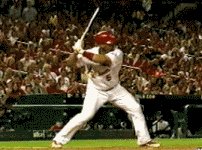
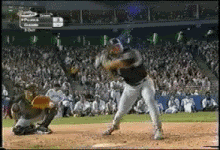
An important historical note: Throughout the great history of hurling there have been MANY prophets of drag, numerous kingdoms, and more than one emperor. The readers of this post have identified several throughout this thread but there are many more.
LA wrote
Indeed! There was a period when the consensus in many kingdoms appeared to be anti-drag. It was a very difficult time. Once discovered, many a drag felt ostracized, their careers got sidetracked, even ruined, and all because of something seemingly as insignificant as a line on the ground? Several tortuous devices were constructed to try and eliminate the dreadful drag.
http://ezinearticles.com/?4-Ba...e-Players&id=1989046
Many remnants remain today although the intent may be a little different now.
http://www.5min.com/Video/Buck...or-Pitchers-23475254
Some more research reveals quite a range of opinions from the experts and quite a few appear to be anti-drag and fully equipped with drills and devices to enforce it. I have Dr. John Bagonzi’s book in front of me…”The Act Of Pitching” on pg 297 “BACK FOOT RELEASE DRILL …To keep the back foot from dragging on release”. You can imagine what the photos of the drill look like.
Coaching Pitchers…McFarland…Section on Back Leg
LA previously quoted one drag theorist:
Yet elsewhere we read by the same theorist:
http://www.pitchingperfect.com/files/Glass_Wall.htm
So…. is drag theory still evolving, has the research been completed, or are we joining the chase for another wild one of these?

Why shouldn't we be just a little skeptical given the entire history of drag? Working from the premise stated by LA earlier why not take a look at a few pitchers who do have draglines.
A crooked/curved? dragline created by the “slap shot” rear leg reaction of Strasburg.
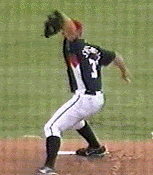
A clip of Wrong Side Sandy?
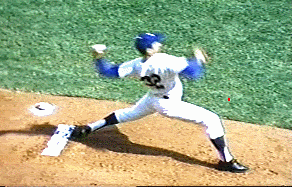
Good thing Brown retired when he did. Multiple release points leading to multiple draglines can now get you into trouble. Vertical line at approx far edge of rubber. Same hitter, same AB. Can't see dragline but can see the back foot reacting differently.
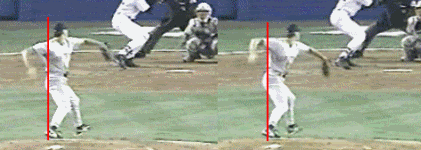

And for those who really love drag…. perhaps the longest line in history…the great Drag Master himself Hideo Nomo!!!
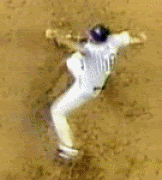
Could move over a little to his left to start though… don’t you think?
And so… in the absence of a deeper understanding of cause and effect, or the realization that exceptions sometimes teach us the most, the same old mindless pendulum of drag appears to just keep swinging from one side to the other.
Music please...
http://popup.lala.com/popup/432627086501351080
quote:Most professional hitters have very little (if any) weight on their back foot at point of contact.
Most obvious with a swing like the young Hank Aaron had. Yet even the short striding “postural perfection”? of the great Mr. Pujols cannot repress rear foot elevation. Not difficult to understand why this happens during the swing…. perhaps a little tougher to see/understand why there is greater variation among throwers?


An important historical note: Throughout the great history of hurling there have been MANY prophets of drag, numerous kingdoms, and more than one emperor. The readers of this post have identified several throughout this thread but there are many more.
LA wrote
quote:Actually, (and I wish I had the references in front of me) there has been some pretty poor coaching in the other direction as well, "Don't drag your foot, son, it'll just slow you down". I'm pretty sure there have been some bizarre drills, maybe involving throwing with the post-foot up on a chair, to train pitchers to get that foot off the ground asap.
Indeed! There was a period when the consensus in many kingdoms appeared to be anti-drag. It was a very difficult time. Once discovered, many a drag felt ostracized, their careers got sidetracked, even ruined, and all because of something seemingly as insignificant as a line on the ground? Several tortuous devices were constructed to try and eliminate the dreadful drag.
quote:Drill #1 - Up & Out Foot Drill Objective - To help pitchers perfect the proper back leg action. The purpose of this drill is to stop foot drag and prevent over striding.
Equipment Needed - A brick, block or wood or other suitable object. The object will be placed at a location just in front of the pivot foot of the pitcher. The pitcher will be working out of the stretch. The pitcher should be reminded to roll and pick his back foot up so that it clears the object.
Procedure - The pitcher throws using his normal motion and delivery. If the pitcher fails to clear the object, then his back foot is "dragging" or he is over striding. Young pitchers should be coached to step out of the "hole" and up and over the block.
http://ezinearticles.com/?4-Ba...e-Players&id=1989046
Many remnants remain today although the intent may be a little different now.
http://www.5min.com/Video/Buck...or-Pitchers-23475254
Some more research reveals quite a range of opinions from the experts and quite a few appear to be anti-drag and fully equipped with drills and devices to enforce it. I have Dr. John Bagonzi’s book in front of me…”The Act Of Pitching” on pg 297 “BACK FOOT RELEASE DRILL …To keep the back foot from dragging on release”. You can imagine what the photos of the drill look like.
Coaching Pitchers…McFarland…Section on Back Leg
quote:“the back foot must not drag – it must leave the rubber immediately. Any time the back foot drags, it kills a lot of the forward momentum that has been built up, diminishing velocity.”
LA previously quoted one drag theorist:
quote:It doesn't matter what shape the dragline is, straight line, arc, zig-zag, etc....they're all fine. What does matter is that the dragline should end on a line middle-of-rubber to middle-of-homeplate.
Yet elsewhere we read by the same theorist:
quote:Measuring the progression of the posting foot from the rubber in distance and direction will tell you how sound a pitcher's mechanics are. Short or crooked draglines indicate bad posture, inappropriate weight shift, and/or premature rotation. The longer the back foot stays on the ground and the straighter his drag foot line, the better his mechanics.
http://www.pitchingperfect.com/files/Glass_Wall.htm
So…. is drag theory still evolving, has the research been completed, or are we joining the chase for another wild one of these?

Why shouldn't we be just a little skeptical given the entire history of drag? Working from the premise stated by LA earlier why not take a look at a few pitchers who do have draglines.
quote:what matters is where the post foot leaves the ground for the last time. That is the end of the dragline and it should be on a line middle-rubber to middle-HP.
A crooked/curved? dragline created by the “slap shot” rear leg reaction of Strasburg.

A clip of Wrong Side Sandy?

Good thing Brown retired when he did. Multiple release points leading to multiple draglines can now get you into trouble. Vertical line at approx far edge of rubber. Same hitter, same AB. Can't see dragline but can see the back foot reacting differently.


And for those who really love drag…. perhaps the longest line in history…the great Drag Master himself Hideo Nomo!!!

Could move over a little to his left to start though… don’t you think?
And so… in the absence of a deeper understanding of cause and effect, or the realization that exceptions sometimes teach us the most, the same old mindless pendulum of drag appears to just keep swinging from one side to the other.
Music please...
http://popup.lala.com/popup/432627086501351080
More good stuff, TG2....I didn't really think you were done chewing on this subject. 
You are definitely correct to suggest that House's ideas evolve. Among many baseball people, evolution is simply taken as a sign of weakness and fallibility.
Scientists, and some baseball people, view the honest evolution of ideas as an inevitable consequence of ongoing study. When you decide that something is not worth studying anymore, for whatever reason, there can really be no further evolution of your thought in that area....for better or worse, that's just a fact.
Now, the "misplaced" end-points shown for some outstanding players (as though I, or somebody, ought to be embarrassed to even think of changing them...)...well, speaking personally, I wouldn't presume to change them.
Exceptions do sometimes teach us the most--I agree with that. What exceptions teach me is this: If someone with a drag-line that finishes way off of middle/middle is not having any problems with command of the zone...I would try not to be foolish enough to "correct" that guy.
If that guy (with a dragline....) is having problems with east-west command of the strike zone, and if I were his coach, one of the things I would do is start looking for his "best" position on the rubber. And....yes...I would start by adjusting him so that the end of his dragline finished middle/middle to see if that helps him. Another thing I would do, unrelated to this conversation, is look for signs of inordinate east-west head movement in his approach to release point.
What if neither of those things helped? Well....maybe there are other experiments to try...I don't like to give up.
TG2, exceptions should hopefully not teach us to ridicule experimentation and study, as though no phenomena with exceptions could possibly be further understood. In exchange, researchers should not be too quick to etch their theories in stone at the first sign of a pattern or unifying theme.
All this philosophy for some lines in the dirt! Gotta love it!
You are definitely correct to suggest that House's ideas evolve. Among many baseball people, evolution is simply taken as a sign of weakness and fallibility.
Scientists, and some baseball people, view the honest evolution of ideas as an inevitable consequence of ongoing study. When you decide that something is not worth studying anymore, for whatever reason, there can really be no further evolution of your thought in that area....for better or worse, that's just a fact.
Now, the "misplaced" end-points shown for some outstanding players (as though I, or somebody, ought to be embarrassed to even think of changing them...)...well, speaking personally, I wouldn't presume to change them.
Exceptions do sometimes teach us the most--I agree with that. What exceptions teach me is this: If someone with a drag-line that finishes way off of middle/middle is not having any problems with command of the zone...I would try not to be foolish enough to "correct" that guy.
If that guy (with a dragline....) is having problems with east-west command of the strike zone, and if I were his coach, one of the things I would do is start looking for his "best" position on the rubber. And....yes...I would start by adjusting him so that the end of his dragline finished middle/middle to see if that helps him. Another thing I would do, unrelated to this conversation, is look for signs of inordinate east-west head movement in his approach to release point.
What if neither of those things helped? Well....maybe there are other experiments to try...I don't like to give up.
TG2, exceptions should hopefully not teach us to ridicule experimentation and study, as though no phenomena with exceptions could possibly be further understood. In exchange, researchers should not be too quick to etch their theories in stone at the first sign of a pattern or unifying theme.
All this philosophy for some lines in the dirt! Gotta love it!
quote:Originally posted by laflippin:
More good stuff, TG2....I didn't really think you were done chewing on this subject.
You are definitely correct to suggest that House's ideas evolve. Among many baseball people, evolution is simply taken as a sign of weakness and fallibility.
Scientists, and some baseball people, view the honest evolution of ideas as an inevitable consequence of ongoing study. When you decide that something is not worth studying anymore, for whatever reason, there can really be no further evolution of your thought in that area....for better or worse, that's just a fact.
Now, the "misplaced" end-points shown for some outstanding players (as though I, or somebody, ought to be embarrassed to even think of changing them...)...well, speaking personally, I wouldn't presume to change them.
Exceptions do sometimes teach us the most--I agree with that. What exceptions teach me is this: If someone with a drag-line that finishes way off of middle/middle is not having any problems with command of the zone...I would try not to be foolish enough to "correct" that guy.
If that guy (with a dragline....) is having problems with east-west command of the strike zone, and if I were his coach, one of the things I would do is start looking for his "best" position on the rubber. And....yes...I would start by adjusting him so that the end of his dragline finished middle/middle to see if that helps him. Another thing I would do, unrelated to this conversation, is look for signs of inordinate east-west head movement in his approach to release point.
What if neither of those things helped? Well....maybe there are other experiments to try...I don't like to give up.
TG2, exceptions should hopefully not teach us to ridicule experimentation and study, as though no phenomena with exceptions could possibly be further understood. In exchange, researchers should not be too quick to etch their theories in stone at the first sign of a pattern or unifying theme.
All this philosophy for some lines in the dirt! Gotta love it!
flippin- Not that it matters but I think I was the one that mentioned House evolving.
nc, I know you did, and it's always interesting to me to gauge how different baseball people respond to the idea of coaches whose teaching/research continues to evolve. Some appear to think that continued study and evolving ideas are a sign of integrity, while some see it just the opposite.
TG2 is also referring to House in his latest post, and I was just trying to respond to some of his remarks...
TG2 is also referring to House in his latest post, and I was just trying to respond to some of his remarks...
quote:quote:
It doesn't matter what shape the dragline is, straight line, arc, zig-zag, etc....they're all fine. What does matter is that the dragline should end on a line middle-of-rubber to middle-of-homeplate.
Yet elsewhere we read by the same theorist:
quote:
Measuring the progression of the posting foot from the rubber in distance and direction will tell you how sound a pitcher's mechanics are. Short or crooked draglines indicate bad posture, inappropriate weight shift, and/or premature rotation. The longer the back foot stays on the ground and the straighter his drag foot line, the better his mechanics.
http://www.pitchingperfect.com/files/Glass_Wall.htm
So…. is drag theory still evolving, has the research been completed, or are we joining the chase for another wild one of these?
quote:nc, I know you did, and it's always interesting to me to gauge how different baseball people respond to the idea of coaches whose teaching/research continues to evolve. Some appear to think that continued study and evolving ideas are a sign of integrity, while some see it just the opposite.
LA
It’s an interesting question and not difficult to see why opinion is divided.
Indeed, some would view the use of the word “evolving” as being kind, and might be a little more direct, and simply say, “looks like they got it wrong again Billy Bob”.
Especially if they were paying a great deal of money for an instruction that is now deemed incorrect but less than a year ago was considered correct. I’m not referring to anything or anyone specific here but if you’ve been around the proverbial block a few times you’ve seen it happen more than once.
Is there anyone out there who wouldn’t prefer that his or her instructor get it right the first time, as unrealistic as this might appear?
So what gives here? Should we just accept that this is an evolving field of study, that we’re all imperfect, and that getting it wrong is to just be accepted? Or is “evolving” becoming a convenient excuse for getting it wrong in advance…. a way of covering your hindquarters, when in truth you should be doing more research before going public and teaching this stuff.
DOUBLESPEAK?
Is the word “evolving” becoming the most recent example of pitching instructional doublespeak?
That is: “evolving” = really means - I got it wrong before and am likely to do it again
Furthermore has “evolving” become a clever marketing tool justifying new and improved products every year regardless of whether they are really needed or improved?
That is “evolving” = really means - I’ve got new products to sell
Is there an instructor out there today who doesn’t promote his work as being science driven or at least science based? Yet baseball-pitching instruction rivals the toothpaste industry when it comes to marketing “new and improved” products. I sense a contradiction here.
Real science is a slow methodical process where new truths are declared only with great caution. Very little is accepted as fact within a scientific community without being subject to the scrutiny of the leaders in the field, peer reviews, approval for publication, etc. It’s a long process, not without problems, but when it works, the fluff gets weeded out.
Not so in the baseball world. For many instructors, the only people reviewing their teachings are lunatic Dads babbling on the Internet.
Many would agree that most of the time we learn through our mistakes and admitting them is a virtue. Yet before we confess all our sins I suppose I should point out that, there are some professions where being wrong often gets you fired, at the very least, sued, thrown in jail or dead at worst. I like it when my neurosurgeon gets it right the first time, a new building doesn’t collapse on my head, and the plane lands on the runway.
I’ve sometimes wondered what would happen if ruining a top prospect got you thrown in jail?
Of course our knowledge of the world continues to evolve, that’s a given. The question is when is it acceptable to be wrong in what you teach while taking payment for your services?
Yes I would prefer my instructor gets it right the first time. Is that realistic…actually in many teaching professions it is indeed, and many of us are alive because of it. But I’ll accept that this will not always be the case with pitching instruction. I can accept the “evolving” explanation, provided that I know the instructor sincerely works hard to uncover the truth. That he has to the best of his ability, researched his product and doesn’t go public before he is as certain as he can be, that it’s a good product or teach. That the instructor’s use of the word “evolution” is not just a way of covering his hindquarters down the road, or simply another marketing ploy.
Sorry for the longwinded reply.
No substitute for doing your own homework and as always,
CONSUMER BEWARE!
Maestro….
http://www.youtube.com/watch?v=xHD0ZdhtmSQ
Great post TG2!!

If someone has all the answers to hitting and pitching, and doesn't need to evolve, please let us know.
The only thing evolving is the BS. Talk about babbling on.
quote:Originally posted by TG2:
lunatic Dads babbling on the Internet.

Hey there are more than a few of us here that resemble this remark... Of course we all know that BHD has never babbled...
HSBBBDW High School BaseBall Babbling Dad Web
TG2: Point made, which is why I go to ASMI to get as much information as possible on the subject. (and heavily filter everthing else)
quote:Real science is a slow methodical process where new truths are declared only with great caution. Very little is accepted as fact within a scientific community without being subject to the scrutiny of the leaders in the field, peer reviews, approval for publication, etc. It’s a long process, not without problems, but when it works, the fluff gets weeded out.
-----Unfortunately, the world of "real science" research has always been plagued by the same list of human fallibilities that were listed for the degradation of the word "evolving". Greed, fatuous complacency, ego, pathological lying, con-artistry and other types of misconduct are all represented throughout the history of science. Fortunately, peer-review and open discussion by interested people eventually helps to sort the wheat from the chafe...
Especially liked your concluding remark: "No substitute for doing your own homework..."
BOF.
Babbling Lunatic was a self-reference of course. It’s nice to know I’m in such good company. Although we should realize… not all-lunatic babble is as it first appears!
LA
Good points…the best and worst of humanity will be with us no matter what the endeavor.
Babbling Lunatic was a self-reference of course. It’s nice to know I’m in such good company. Although we should realize… not all-lunatic babble is as it first appears!
quote:
Tell all the Truth but tell it slant---
Success in Cirrcuit lies
Too bright for our infirm Delight
The Truth's superb surprise
As Lightening to the Children eased
With explanation kind
The Truth must dazzle gradually
Or every man be blind---
Emily Dickinson
LA
Good points…the best and worst of humanity will be with us no matter what the endeavor.
I have brought about this thread from the past because I recently made an updated video about this that I placed on youtube.
http://www.youtube.com/watch?v=xtUDQqM3PNs
The last reply was a year and a half ago and still the topic of importance or non importance lingers.
I hope this brings about a simplistic thought about the drag line.
Leonardo Da Vinci once said that "Simplicity is the ultimate sophistication." I wasn't there when he said it, but I understand exactly what he meant by it. Why can't we look at things in a simple matter? Why is simplicity so tough? You don't buy simple stuff because it doesnt cost anything. Things have to be complex. With complexity there is challenge. We pay big bucks for complexity. Simplicity doesn't sell. If it is simple, we feel like meatheads. Why can't we look at things and go "I understand, move forward."
Example: Diet books and diet pills make tons and tons of money. Why? Because hearing that you need to exercise more than you eat is too simple of a concept. Burn more calories by getting off your tail than take in and you will not become obese? How much for that info?
Oh well, I will get off my soap box. Hope the video brings about simplicity and interaction pertaining to the actions of the back foot and the great inforamtion it can bring about by watching the path it takes, either on the ground or in the air.
In air or on ground is irrelevant because it occurs after stride foot plant. If it occurs before stride foot plant, it is the result of an enormous amount of drive and desire for greater stride length.
http://www.youtube.com/watch?v=xtUDQqM3PNs
The last reply was a year and a half ago and still the topic of importance or non importance lingers.
I hope this brings about a simplistic thought about the drag line.
Leonardo Da Vinci once said that "Simplicity is the ultimate sophistication." I wasn't there when he said it, but I understand exactly what he meant by it. Why can't we look at things in a simple matter? Why is simplicity so tough? You don't buy simple stuff because it doesnt cost anything. Things have to be complex. With complexity there is challenge. We pay big bucks for complexity. Simplicity doesn't sell. If it is simple, we feel like meatheads. Why can't we look at things and go "I understand, move forward."
Example: Diet books and diet pills make tons and tons of money. Why? Because hearing that you need to exercise more than you eat is too simple of a concept. Burn more calories by getting off your tail than take in and you will not become obese? How much for that info?
Oh well, I will get off my soap box. Hope the video brings about simplicity and interaction pertaining to the actions of the back foot and the great inforamtion it can bring about by watching the path it takes, either on the ground or in the air.
In air or on ground is irrelevant because it occurs after stride foot plant. If it occurs before stride foot plant, it is the result of an enormous amount of drive and desire for greater stride length.
My thoughts are that it is good. I see balance in his approach and the way his back foot works (pause at 6:08)and you will see it come behind his stride line, that would be an example of it counter balancing his rotation. So yes, I think it is good for him and I like it.
As far as foot rolled over and laces pointed down, that is a different clip I am going to make in reference to the "Common Sense understanding of Stride Length and Hip to Shoulder Separation." Coming soon.
As far as foot rolled over and laces pointed down, that is a different clip I am going to make in reference to the "Common Sense understanding of Stride Length and Hip to Shoulder Separation." Coming soon.
Looking forward to it. I do see one particular negative in the foot roll over/laces down in that it may not be optimizing a pitcher's leverage. Pitchers are taught to stay on top of the ball and throw downhill, and this causes a drop in the hips that could be detrimental to that capability. Even guys like Tom Seaver, who in my opinion epitomizes maximization of stride (although Koufax gives him a run for his money), was able to keep his hips forward moving and his chest over his front side upon release/follow through. With the foot roll over, I think the drop in the hips could hinder forward momentum and cause inconsistent velocities and excess stress on the arm.
Just some thoughts from my perspective, looking forward to your opinion on the topic.
BTW, we had Perry Husband on this Sunday, he made sure to say hello to you. Brilliant guy, spoke highly of your experiment with him about fastball speed changes for winter at bats. I was going to bring it up on air but we ran out of time.
Just some thoughts from my perspective, looking forward to your opinion on the topic.
BTW, we had Perry Husband on this Sunday, he made sure to say hello to you. Brilliant guy, spoke highly of your experiment with him about fastball speed changes for winter at bats. I was going to bring it up on air but we ran out of time.
The rolling of the back foot has to occur so the back side can fire through. Try to square up your back hip to the target without rolling to the laces. Those that have trouble with this will look like a dog over a fire hydrant just after release. The aspect of the athlete not having leverage at that point doesn't make a great deal of sense to me because it is occuring after foot strike and all energy fires forward as a result of the braking mechanism of the stride foot plant.
Drag line importance or lack of?
Watch Smoltz right hip fire as he rolls to his laces and the important thing for me, is notice the distance between knees as he does so. When the back hip can fire, it can assist the throwing arm, which we both know is a good thing.
I will post a clip of a young CC Sabathia of how Elvis's little move that Forest Gump taught him is important in pitching.
I will edit it and attach it to this post.
Drag line importance or lack of?
Watch Smoltz right hip fire as he rolls to his laces and the important thing for me, is notice the distance between knees as he does so. When the back hip can fire, it can assist the throwing arm, which we both know is a good thing.
I will post a clip of a young CC Sabathia of how Elvis's little move that Forest Gump taught him is important in pitching.
I will edit it and attach it to this post.
I agree with the Smoltz thing, and I was referring to the roll prior to release. I'm aware this isn't ideal, but I have seen it happen a few times:

This particular example is what I was referring to when I mentioned the hip action. In the case of Wheeler, though, I do agree that it is not detrimental because it assists that "braking" action you spoke of. I do think that up until actual release, the body should continually be moving forward, and the premature roll highlighted above is an example of that not happening.
Maddux rolled a bit after release as well:


This particular example is what I was referring to when I mentioned the hip action. In the case of Wheeler, though, I do agree that it is not detrimental because it assists that "braking" action you spoke of. I do think that up until actual release, the body should continually be moving forward, and the premature roll highlighted above is an example of that not happening.
Maddux rolled a bit after release as well:

quote:Originally posted by Fred Corral:
The rolling of the back foot has to occur so the back side can fire through.....
Drag line importance or lack of?
I will post a clip of a young CC Sabathia of how Elvis's little move that Forest Gump taught him is important in pitching.
Here it is...enjoy.
Unlocking the Lower Half
quote:Originally posted by J H:

the body should continually be moving forward, and the premature roll highlighted above is an example of that not happening.
Not necessarily the body, but the upper half. The upper half moves forward from a convex position to a concave position to release and after the body will adjusts in attaining balance.
Your statement about the picture above is true for me because of the fact that the back leg is straight at release.
This shows one of two things:
1. The pitcher is upperbody aggressive, minimizing lower half energy.
2. The stride is too short to allow for lower half drive causing the individual to be upright and inefficient or visa versa.
Agreed, thanks Fred.
quote:Originally posted by Fred Corral:
I have brought about this thread from the past because I recently made an updated video about this that I placed on youtube.
http://www.youtube.com/watch?v=xtUDQqM3PNs
The last reply was a year and a half ago and still the topic of importance or non importance lingers.
I hope this brings about a simplistic thought about the drag line.
Leonardo Da Vinci once said that "Simplicity is the ultimate sophistication." I wasn't there when he said it, but I understand exactly what he meant by it. Why can't we look at things in a simple matter? Why is simplicity so tough? You don't buy simple stuff because it doesnt cost anything. Things have to be complex. With complexity there is challenge. We pay big bucks for complexity. Simplicity doesn't sell. If it is simple, we feel like meatheads. Why can't we look at things and go "I understand, move forward."
Example: Diet books and diet pills make tons and tons of money. Why? Because hearing that you need to exercise more than you eat is too simple of a concept. Burn more calories by getting off your tail than take in and you will not become obese? How much for that info?
Oh well, I will get off my soap box. Hope the video brings about simplicity and interaction pertaining to the actions of the back foot and the great inforamtion it can bring about by watching the path it takes, either on the ground or in the air.
In air or on ground is irrelevant because it occurs after stride foot plant. If it occurs before stride foot plant, it is the result of an enormous amount of drive and desire for greater stride length.
Wow, learn something new everyday. I watched the video you posted and then went and watched some video of my son pitching. I knew he had a drag line but was wholly unaware that he was making that little checkmark mark with the foot first going one direction and then going the opposite direction after the foot rolled over and into lift-off.
Thanks a bunch. I went back and read the whole thread and your video kind of brought it all together. Thanks.
quote:“Seek simplicity…and distrust it” Alfred North Whitehead
In what direction is Lincecum’s Drag line going?
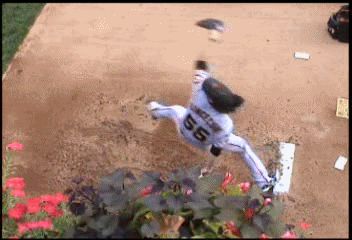
Koufax?
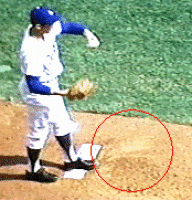

quote:“It requires a very unusual mind to undertake the analysis of the obvious” Alfred North Whitehead
quote:Originally posted by TG2:quote:“Seek simplicity…and distrust it” Alfred North Whitehead
In what direction is Lincecum’s Drag line going?
Koufax?
 quote:“It requires a very unusual mind to undertake the analysis of the obvious” Alfred North Whitehead
quote:“It requires a very unusual mind to undertake the analysis of the obvious” Alfred North Whitehead


TG2,
Nice.
How long have you been doing this coaching thing?
That is really nice.
I commend you..
quote:Originally posted by Fred Corral:quote:Originally posted by TG2:quote:“Seek simplicity…and distrust it” Alfred North Whitehead
In what direction is Lincecum’s Drag line going?
Koufax?
 quote:“It requires a very unusual mind to undertake the analysis of the obvious” Alfred North Whitehead
quote:“It requires a very unusual mind to undertake the analysis of the obvious” Alfred North Whitehead


TG2,
Nice.
How long have you been doing this coaching thing?
That is really nice.
I commend you..
....but I disagree with your examples.
I am taking this, as you attempting to go against my thought process of simplicity, and how the drag mark displays balance with in the delivery. Like you, I don't see that the drag mark is an essential act in pitching, but can be a great teaching tool for understanding balance within the approach. I tried to convey that in the clip I created and even went so far as to stand in front of 6oo of my peers with Tom House and express it's lack of importance of being on the ground or in the air.(ABCA Clinic "Pitching Hot Stove"- Dallas TX 2010.) Coach House demonstrated this with me standing in a lunge position at release and asked me to push against his hand. Then we did the same test with my back foot in the air. Obviously I was stronger with my back foot on the ground. This was a poor test for his theory and I made it clear at that point that it would be relevant if we had to pitch from that position. If so, it would eliminate the whole loading phase of the delivery and unloading phase working off the braking mechanism of the stride foot plant. (Using the example of a crashing car, that the back wheels were going to come forward whether on the ground or not.)
I thought you did a very good job of bringing it about as well, though your approach of doing so in this thread was not the best for me.
I had the privilege of spending the next two hours having dinner with him and the USC staff where we discussed a lot of things that "I was so close to figuring out". It was great and he was great.
Simplicity is the key. Your quotes by Whitehead were silly for me, and they were silly also when I heard Dr. Marshall use the quote of Whitehead's to express to me that "Common Sense is genius in homespun." My thoughts for him went south as quite frankly both examples are of fools. (Simplicity and Common Sense brings about understanding.) I am ok in stating this because of where 20 plus years have taken me in this quest of simplifying the approach and that there “are no always or nevers” and we are not robots. If this be the thoughts of someone with Whitehead's mind it goes to show that we, as human beings are not perfect. (Even our smartest of people) That the best surgeon loses a patient, the best pilot can sadly crash, and that Michael Jordan can miss a few game winning shots. etc...and with that I can be wrong as well.
Now to your examples

Lincecum shows me a pretty good drag line. My example in the video if you saw it was to show that, when balance occurs (lower half working with upper half) You would see a number”7” type action of the drag mark on the ground or in the air from a LHP and the opposite of “7” or “<” for a right hander whether on the ground or in the air. You did a good job of showing this with the gif’s of Eckersley and others. I even attempted to explain why that was the case with my diagram with Smoltz (below) and my example of getting on a rotating chair. This is the reason for my viewing TL’s drag mark in this clip as ok. TL’s rotation of his upper half is more of a “Ferris wheel” as Smoltz is more towards a merry-go-round. (It is why Eckersley and others can bring their foot up in the air) You can see how TL’s wants to start going behind stride line but cannot because of his posture to throw like a “Ferris wheel.” You had enough info to write all those stories and share all those pics and this should have fired you up with the simplicity of it and you couldn’t pull off why TL’s went out to arm side?
I will explain Koufax,or as you so pleasantly put him as “Wrong Side Sandy”,if you want me to But maybe you can figure this one out on your own.
I admit I am a bit of a smarty pants with you but I don’t tell wonderful fairytale stories like you and carve into well minded people. (I hate this, it seems so “knocking down towers – like”.) My apologies in advance, but simplicity is the only measure.
Note: I would not reply like this if there wasn't a dig with the Whitehead quotes.

quote:,“There are no whole truths; all truths are half-truths. It is trying to treat them as whole truths that plays the devil.” Whitehead
Fred,
Thanks for your thoughtful reply. As a coach working with players I couldn’t agree more that the KISS approach (Keep It Simple Stupid) works best for the majority of players. Simple cues are far more likely to “click” than lengthy detailed explanations.
It does not follow however that the act of throwing and hitting a baseball is something simply understood or explained as we should all know. There is indeed beauty in simplicity when it is genuine, but over simplification can be misleading at best, counterproductive and dangerous at worst.
Unfortunately when it comes to understanding drag lines simplicity all to often becomes simplistic.
For example…as recalled previously in this thread there was a period when many well thought of college pitching coaches (I have their books if you want them) thought any dragging of the foot was slowing you down. So they resorted to placing buckets or bricks in front of the rubber to get the back foot flying up in the air.
Number one pick Garret Cole would have been a star pupil back in that day….his triple digit velocity would be seen as proof of why you don’t want to drag the toe. Yet how many pitchers with perfectly sound toe dragging mechanics were ruined by this simplistic understanding of what drag lines (or lack of) mean?
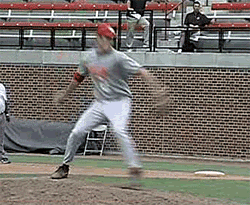
Fast forward to today and we have several leading instructors who claim the foot must drag to achieve maximum velocity and the foot on the ground near release also helps with control. Ah again, Garret Cole’s velocity is pretty good and last I checked Cliff Lee has no drag line to speak of and his control isn’t suffering.
What to make of the leagues hardest throwing starter for three years prior to this past year Ubaldo Jimenez? Not only is there practically no drag line… there is hardly any gap between his back foot and the rubber upon release.
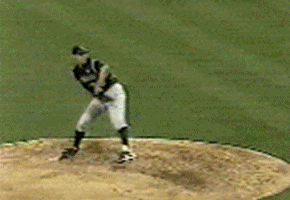
This would appear to contradict those who associate long powerful drag lines with velocity. Somewhere in the distance I can hear an old friend beating the rotational drum…
And now if I understand your presentation correctly you are saying that a back foot which immediately goes out to the throwing arm side indicates poor use of the hips and lower body. Yet that is exactly what is going on with Lincecum and Koufax, who in my opinion get much more out of their lower bodies than John Smoltz. Incidentally, in the case of Lincecum, his foot going to the right is not entirely explained by his dominant “ferris wheel” delivery.
Yes the back foot kicking over is a counter balancing reaction to the upper body and this hockey “slap shot” reaction can be seen in many pitchers…bending over from the waist in a lower release forces greater counter reaction. Think bowlers. However I don’t see this reaction as a key indicator which definitively determines whether a pitcher has made good use of his hips….again look at Koufax and Lincecum.
Finally, I’ve nothing but respect for your quest to more thoroughly understand what it takes to throw a baseball and you are undoubtedly one of the most knowledgeable coaches in the game today. What’s more, you are exceedingly generous with sharing your explorations for which we are all grateful. Very few coaches have the guts to be as open and helpful as you.
You revived this thread and I’m responding with my 2 cents. Looking forward to learning more from your response.
quote:“A clash of doctrines is not a disaster—it is an opportunity” Whitehead
Happy New Year and keep up the good work!
quote:Originally posted by TG2:
And now if I understand your presentation correctly you are saying that a back foot which immediately goes out to the throwing arm side indicates poor use of the hips and lower body. Yet that is exactly what is going on with Lincecum and Koufax, who in my opinion get much more out of their lower bodies than John Smoltz. Incidentally, in the case of Lincecum, his foot going to the right is not entirely explained by his dominant “ferris wheel” delivery.
When the back foot drag goes out to arm side, for me, it is an indication that the lower half is not working with the upper half. When the athlete is “upper body aggressive,” you will see a straight line from release to back foot as well as the path of the drag line out to arm side. My example with Prior was to show him as “balanced” approach (upper half working with lower half) in a game vs an “imbalanced” approach in which he is using more upper body than lower half (doing the towel drill). With TL’s approach, I would not be one to say that he uses his lower half poorly. As I mentioned in the previous response, he shows me that he uses his lower half pretty good. You are correct that it cannot be entirely explained by his “ferris wheel” upper half. It factors in greatly with how I see the approach as using his lower half optimally in connection with his upper half. Just looking at his drag and figuring out what I just expressed…..TL’s back foot works in such a way as to follow his direction line at the start because of his great leg drive or push. It then will go toward the target at and on his stride line when the shoulders start to rotate. Because of the ferris wheel like approach of his upper half and or the posture taken to pitch from his arm slot this action will be short and will have to start out toward his arm side as an act of balance. These actions occur because there is balance and connection with top and bottom halves.

As for Sandy Koufax, (Who is my all time favorite) you will see that his drag line goes out to arm side immediately. This is a strong indication for me that there is an imbalance in his approach.
The length of his stride length made him very upper body dominant and you can see that in a lot of his game footage in which his back side foot rarely finish even or ahead of his stride foot. It always had that tugging back toward 2nd base look. Both are large stride guys and the launch that makes TL’s lower half work better is the missing component for me that Koufax didn’t have and ultimately it may or may not have contributed to Koufax’s exit at the age and productivity he was at.
quote:.....However I don’t see this reaction as a key indicator which definitively determines whether a pitcher has made good use of his hips….again look at Koufax and Lincecum.
I would agree and again re-iterate that it is not about the use of hips but and indication of balance or connection of lower half with upper half.
I hope this explains my thoughts and especially my clip on understanding the drag line as a understanding of "balance or imbalance". Which, for me, translates to "efficient or inefficient", "healthy or unhealthy," and or "something you want" or "something you don't want."
quote:“A clash of doctrines is not a disaster—it is an opportunity” Whitehead
If I understand his one of Whithead's clearly and not saying that I do because I am not that bright, but I agree.
Happy New Year as well and to all!
Fred,
Will respond to your most recent post in greater detail in a day or two when I return from the festivities. For now here are some clips of Kevin Brown and Juan Marichal throwing from different release points. It’s a good illustration of how their back foot reacts to varying postures through release.
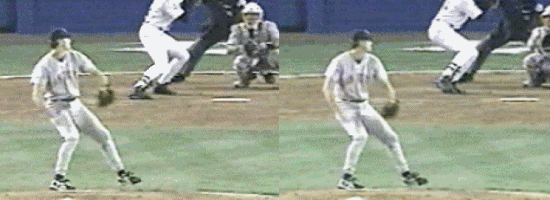
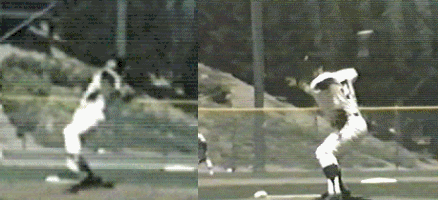
Go to the mound after Brown, Marichal, Tiant, or a late career Musina, has thrown an inning and you’d think there were at least two different pitchers out there given the varied marks in the dirt.
Enough for now….let the party begin!!!
Will respond to your most recent post in greater detail in a day or two when I return from the festivities. For now here are some clips of Kevin Brown and Juan Marichal throwing from different release points. It’s a good illustration of how their back foot reacts to varying postures through release.


Go to the mound after Brown, Marichal, Tiant, or a late career Musina, has thrown an inning and you’d think there were at least two different pitchers out there given the varied marks in the dirt.
Enough for now….let the party begin!!!
Nicely done TG2! 
Needed the break. Where in the past many night clubs had to re-varnish their dance floors after I was done...I am now the victim of "Just Dance 3". New Years party at my place consisting of my 11 year old daughter and her girlfriends. Getting old.
Needed the break. Where in the past many night clubs had to re-varnish their dance floors after I was done...I am now the victim of "Just Dance 3". New Years party at my place consisting of my 11 year old daughter and her girlfriends. Getting old.
Fred,
Sorry for delay, if you’re still out there, some thoughts on the Kevin Brown and Juan Marichal clips.
We can see that the different release points produce two different back foot reactions within the same pitcher. So which reaction is better? To make a value judgment between them in this instance seems misguided, as the differences appear to be primarily a natural reaction to different postures and release points.
The above example suggests that what might be a good drag line for one way of throwing is not so good for another. Hence having just one universal continuum from, bad to good, for all types of pitchers doesn’t appear comprehensive enough IMO.
Of course, to the scientifically minded, the connection between how the back foot reacts, and greater mechanical efficiencies, would likely have to be proven using motion analysis data across a wide variety of subjects. For example does the back foot reacting inward or outward stem from greater or lesser hip velocity? It’s possible that the ASMI already has all the necessary data you’d need in their “elite” pitchers data bank. Someone would have to go through the numbers looking for connections between the things your interested in.
All I can do with video is try and offer some constructive speculations, which is usually a good beginning and certainly okay for now.
Here are some links to a submarine pitcher who appears to have a rather extreme immediate inward reaction.
http://www.youtube.com/watch?v=uZJzNTxgIx0
http://www.youtube.com/watch?N...e=fvwp&v=cadtGulEJZw
It seems obvious enough that as one increasingly bends over to the right from the waist they will need to counterbalance with a leftward leg slide, and yet other variables, such as stride direction and length, tempo, timing of leg extension and back foot turn over…work against simple uniformity, even among submariners.
Check out all these down-unders!
http://www.youtube.com/watch?v=RQCz6nSHuwA
Looking back through my video archives I’ve yet to recognize a convergence of drag line types or back foot reactions among elite level throwers, rather I see a diversity that can only be deciphered one pitcher at a time. Here is a clip of two hard throwing RH’s, Kyle Farnsworth and Brain Wilson.
Here is another link to Wilson.
http://www.youtube.com/watch?v=ntFrmmv9fQY

Farnsworth goes in initially, Wilson mostly out to the right.
Maddux is another pitcher who might go forward a smidgen before making a hard right. What is your take on his drag line?
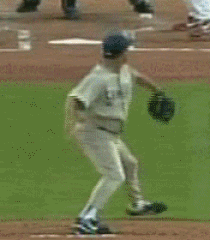
Here is a good overhead link.
http://www.youtube.com/watch?v...49Vc&feature=related
Then there is the interesting case of a leaping Jordan Walden who goes immediately opposite arm side. His leaping action appears to be creating and interesting response in the back foot.
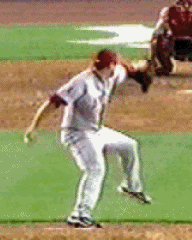
No doubt drag lines and back foot reactions should be able to tell us something about a pitchers delivery. However when individual variations combine with an infinite number of ways to throw a baseball unraveling cause and effect is not so simple.
Seeing through a haze of complexity to discover a genuine unifying pattern is a great moment in human thought and I commend your efforts in this direction. However, after having been down these roads several times, you’ll have to forgive me for becoming a little suspicious of answers which appear too easy, and “absolutes”, which, after some additional research, prove to be just more “variables” a few months later. It might be good marketing to simplify the package but the reality is often more complicated.
Continuums usually appear closer to reality than narrowly defined absolutes, but even these broader frameworks will sometimes obscure the unique. In my experience you only arrive at true simplicity after having worked through a very large pile of complexity…and obviously I’m still shoveling.

PS,
As I mentioned before one of the most instructive drag lines turns out to be a pitcher with practically no drag line at all. His back foot turns over with very little separation from the rubber until after release, contrast this with the distance Lincecum comes off the rubber.
http://www.youtube.com/watch?v=lch6IwadoQ8
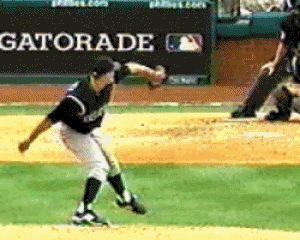
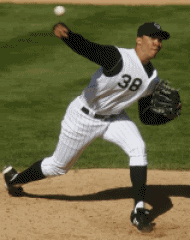
I’m not suggesting everyone adopt his technique in a specific way, rather, keep him in mind when thinking about where the true source of power in a delivery comes from.
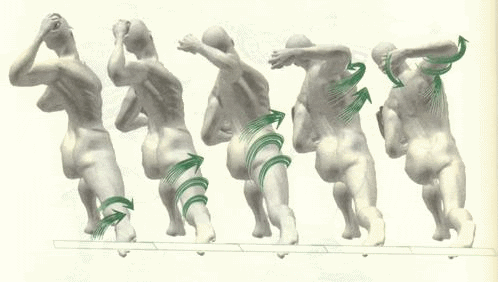
I’m done…
Sorry for delay, if you’re still out there, some thoughts on the Kevin Brown and Juan Marichal clips.
We can see that the different release points produce two different back foot reactions within the same pitcher. So which reaction is better? To make a value judgment between them in this instance seems misguided, as the differences appear to be primarily a natural reaction to different postures and release points.
The above example suggests that what might be a good drag line for one way of throwing is not so good for another. Hence having just one universal continuum from, bad to good, for all types of pitchers doesn’t appear comprehensive enough IMO.
Of course, to the scientifically minded, the connection between how the back foot reacts, and greater mechanical efficiencies, would likely have to be proven using motion analysis data across a wide variety of subjects. For example does the back foot reacting inward or outward stem from greater or lesser hip velocity? It’s possible that the ASMI already has all the necessary data you’d need in their “elite” pitchers data bank. Someone would have to go through the numbers looking for connections between the things your interested in.
All I can do with video is try and offer some constructive speculations, which is usually a good beginning and certainly okay for now.
Here are some links to a submarine pitcher who appears to have a rather extreme immediate inward reaction.
http://www.youtube.com/watch?v=uZJzNTxgIx0
http://www.youtube.com/watch?N...e=fvwp&v=cadtGulEJZw
It seems obvious enough that as one increasingly bends over to the right from the waist they will need to counterbalance with a leftward leg slide, and yet other variables, such as stride direction and length, tempo, timing of leg extension and back foot turn over…work against simple uniformity, even among submariners.
Check out all these down-unders!
http://www.youtube.com/watch?v=RQCz6nSHuwA
Looking back through my video archives I’ve yet to recognize a convergence of drag line types or back foot reactions among elite level throwers, rather I see a diversity that can only be deciphered one pitcher at a time. Here is a clip of two hard throwing RH’s, Kyle Farnsworth and Brain Wilson.
Here is another link to Wilson.
http://www.youtube.com/watch?v=ntFrmmv9fQY

Farnsworth goes in initially, Wilson mostly out to the right.
Maddux is another pitcher who might go forward a smidgen before making a hard right. What is your take on his drag line?

Here is a good overhead link.
http://www.youtube.com/watch?v...49Vc&feature=related
Then there is the interesting case of a leaping Jordan Walden who goes immediately opposite arm side. His leaping action appears to be creating and interesting response in the back foot.

No doubt drag lines and back foot reactions should be able to tell us something about a pitchers delivery. However when individual variations combine with an infinite number of ways to throw a baseball unraveling cause and effect is not so simple.
Seeing through a haze of complexity to discover a genuine unifying pattern is a great moment in human thought and I commend your efforts in this direction. However, after having been down these roads several times, you’ll have to forgive me for becoming a little suspicious of answers which appear too easy, and “absolutes”, which, after some additional research, prove to be just more “variables” a few months later. It might be good marketing to simplify the package but the reality is often more complicated.
Continuums usually appear closer to reality than narrowly defined absolutes, but even these broader frameworks will sometimes obscure the unique. In my experience you only arrive at true simplicity after having worked through a very large pile of complexity…and obviously I’m still shoveling.
PS,
As I mentioned before one of the most instructive drag lines turns out to be a pitcher with practically no drag line at all. His back foot turns over with very little separation from the rubber until after release, contrast this with the distance Lincecum comes off the rubber.
http://www.youtube.com/watch?v=lch6IwadoQ8


I’m not suggesting everyone adopt his technique in a specific way, rather, keep him in mind when thinking about where the true source of power in a delivery comes from.

I’m done…
I would not consider a back foot drag good or bad in the sense that it depends on what the pitcher is like. If he has a little less flexability, it may actually help with hip seperation, thus creating more torque and more velocity. on the other hand, if he is flexable enough to not need it and still get the same hip seperation, then it would be unneeded. It really depends on the type of pitcher because i have seen many successful with drag and still some who do without it. many great points by the way i just thought i would put in my 2 cents
quote:Originally posted by bigheat27-42:
I would not consider a back foot drag good or bad in the sense that it depends on what the pitcher is like. If he has a little less flexability, it may actually help with hip seperation, thus creating more torque and more velocity. on the other hand, if he is flexable enough to not need it and still get the same hip seperation, then it would be unneeded. It really depends on the type of pitcher because i have seen many successful with drag and still some who do without it. many great points by the way i just thought i would put in my 2 cents
I agree with you,,it DEPENDS on the amount of drag and the type of pitcher,,I have a kid with foot drag that almost rips his toe off..he's a senior throwing 85..his drag is so prevelant it slows him down ,,most pitchers do drag a wee bit..
Sounds like "to drag" or "not to drag" is irrevelant but what is important are all the other important mechanics before the pitch is released.
4 pages of overanalyzing something no aspiring pitcher should worry about.
4 pages of overanalyzing something no aspiring pitcher should worry about.
Add Reply
Sign In To Reply


